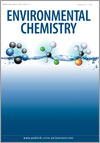EN13036Combination of nitrate (N, O) and boron isotopic ratios with microbiological indicators for the determination of nitrate sources in karstic groundwater
Environmental context. Nitrate contamination of drinking water quality may be critical, particularly in rural areas where agricultural practices may release large amounts of nitrogen. Knowledge of the source of such contamination, mandatory for water supply management, can be successfully acquired by combining the natural stable isotopes of nitrate, boron isotopic ratios and microbiological indicators.
EN13036 Abstract | EN13036 Full Text | EN13036PDF (294 KB) Open Access Article




